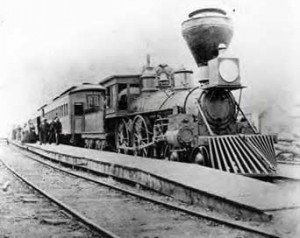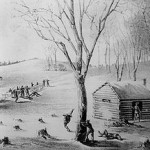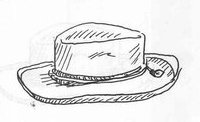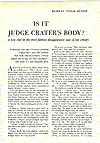Much to my embarrassment,” Wilson Mizner admitted, “I was born in bed with a lady.” His second passion was theft. One of his few heroes, Jefferson Randolph “Soapy” Smith, the criminal boss of Skagway during the Gold Rush of 1898, observed, “When I see anyone looking in a jewelry store window thinking how they would like to get away with the diamonds, an irresistible desire comes over me to skin them.” Mizner never resisted such desires.
His third passion was the wisecrack. Mencken called him “the sharpest wit in America since Mark Twain” and said that he spun off more jests, as casually as a man tossing away a cigarette butt, than any other citizen of the United States. Our loss is that, as John Burke, one of his biographers, wrote, “many of his best quips vanished into a bellow of laughter…and a swirl of cigar smoke and whiskey fumes.”
Still, a few survived:
“I respect faith, but doubt is what gets you an education.”
“A fellow who tells you that he’s no fool usually has his suspicions.”
“If you copy from one author, it’s plagiarism. If you copy from two, it’s research.”
“A dramatic critic is a guy who surprises the playwright by informing him what he meant.”
“The difference between talking out of turn and a faux pas depends on the kind of bar you’re in.”
“I hate careless flattery, the kind that exhausts you in your effort to believe it.”
“I can judge a man by what he laughs at.”
“I never saw a mob rush across town to do a good deed.”
“Hollywood almost made a good picture once, but they caught it just in time.”
Mizner had great presence: he was six feet, three inches tall, over two hundred pounds, and impeccably tailored (he patronized Bullock & Jones of San Francisco, whom he stiffed). He had left home at seventeen, twelve years before his 1905 arrival in New York. After playing piano in a whorehouse, he landed in the medicine show business. Dr. Silas Slocum, creator of Doc Slocum’s Elixir, needed a talker to reel off learned-sounding phrases in Latin. “Let’s hear you speak a piece of it,” Slocum commanded. Mizner thundered a string of Spanish curses and obscenities, picked up while his father was American minister to Guatemala. “You’re hired,” the doctor declared.
In 1898, Mizner headed for the Klondike with his girlfriend, Rena Fargo. A brunette singer and dancer, Rena proved useful among a horde of men deprived of female company. Guys would do things for her that they wouldn’t do for Wilson.
Mizner went to Alaska to prospect among the miners’ pockets. He believed the providers of essential services such as whores, pimps, dive keepers, madams, and gamblers, were far more likely to strike it rich. He became a faro dealer. He knew something about cards. (An assistant district attorney once asked how long he had been playing chemin de fer. “Since infancy,” Mizner replied.) Rena, pretending to be a stranger, had amazing runs of luck at his table.
“Once,” Mizner said, “I dealt the coldest of decks involving just fifty-two aces and I have never set eye on a more larceny-haunted set of faces than those before me when they picked up their cards. They were like gents with an uncomfortable chaw of tobacco at a funeral. Each one began a mental race to determine how to keep calm and get rid of the extra ace…Each one figured it was an imperfect pack, but the only interest was not in correcting it, but in making it work, once.” They all bet furiously then one-by-one discarded and drew. “As each one discovered he had drawn an ace,” Mizner continued, “I was afraid my appendix would burst, but I did not move a line of my conniving face. Every one of them believed he had picked up his own discard. Hope would not die.” They laughed—a little too heartily—when they realized they had been had.
Eventually, the time came to depart from the North: the local paper now had a society column and the red lights no longer blazed like fireflies on a July night. Lace curtains had gone up and signs like Ye Olde Whore Shoppe had come down.
His brother, Addison, had broken into New York society as a fashionable architect. Harry K. Thaw’s murder of Stanford White left a place Addison hoped to fill. (Addison himself was no slouch in the field of carnal recreation, and at least commentator observed, “Thaw shot the wrong architect.”) At a horse show, Wilson found Addison amid his friends from the Four Hundred.
“Where are you stopping, now that you’re in town?” Addison asked.
“In a cathouse at Broadway and Forty-second Street,” Wilson boomed truthfully. “I just sit there all day reading my beloved books and smoking opium.”
Wilson met Myra Yerkes, the estranged wife of Charles Tyson Yerkes, the traction magnate. Thanks to peroxide, she was still blonde. Her mansion, modeled after a Roman villa, was furnished in Imperial Bad Taste. She had the social style of a steam calliope.
Mr. Yerkes died in December 1905 before he could divorce Myra, and she married Wilson in January 1906. It lasted six months. Addison called to find Wilson lying on a rococo bed once owned by King Ludwig of Bavaria, wearing long woolen underwear and rolling a brown paper cigarette. “Why did you do it?” Addison inquired. “The service is good here,” said Wilson. He rang a bell and his valet, a former Barbary Coast bouncer, entered bearing a silver salver. On it were two whiskies, one for Addison and one for the valet, and a loaded hypodermic containing a soupcon of morphine to ease the pain of being a rich woman’s consort.
Myra paid Wilson’s bills but refused him folding money. She even hired detectives to keep him from stealing. (“It’s a damned unpleasant experience to be stopped by two Pinkertons when you’re walking out of your own house with a lard can full of jewels.”).
Yerkes had left his paintings to the city of New York. The city government, aware of Mizner’s reputation, let him know he would be personally responsible for any missing paintings. Mizner understood New Yorkers couldn’t resist a bargain in hot merchandise. After putting a small army of starving artists to work copying the masterpieces in Yerkes’s collection, Mizner set up the Old Masters’ Art Society at 431 Fifth Avenue. Then he circulated the rumor that “a bargain in genuine old masters was available to anyone who didn’t mind owning something which nitpickers might classify as stolen property.”
He never claimed the works on sale in his gallery were originals. Only his confidential manner, conspiratorial tone, and frequent glances out the shop window indicated the purchaser was joining a plot against the city treasury. He even managed to sell several copies of the Mona Lisa. A few years later, he would revive the gallery, but by then there was too much competition. He was outraged when forced to sell Leonardo’s The Last Supper for $65. (“I’ll be damned if I sell it for less than five dollars a plate.”)
After his divorce, he managed the Rand Hotel, which catered to crooks, whores, pimps, kept women and their keepers, and the card sharps working the Atlantic liners.
The card sharps were extraordinary. Even Mizner couldn’t beat them. Once, he spread out a hand containing four queens, “which had come into his possession by no accident.” His opponent, of whom Damon Runyon later said, “If you give him a box of soda crackers he can deal you four of a kind,” displayed four kings. “You win,” Mizner said, “but those are not the cards I dealt you.”
Mizner required his guests to observe a few simple rules: “No opium smoking in the elevators…Guests must carry out their own dead…Guests jumping out of windows will try to land in the net placed around the third floor.” A story in the New York Morning Telegraph said, “If a man named Butler or Francis subscribed himself as ‘Harrison’ on the register, Mr. Mizner never gruffly called his attention to the error, but with the courtliness of the old school affected not to notice it.”
Mizner then worked on Broadway. In 1909, with George Bronson Howard, he created The Only Law, perhaps the first hard-boiled play. A year later, he met Paul Armstrong, another graphomaniac. They squabbled over Mizner’s work habits and Armstrong’s plagiarism (after listening to the eulogy at Armstrong’s funeral, Mizner said, “If Paul was up and about, he’d say that speech was his.”) Yet their creations, The Deep Purple, The Ocean Greyhound, and Alias Jimmy Valentine, were all highly profitable.
Mizner’s companions created a number of informal societies out of their friendships. These included the Correspondence School of Drinking—which had as its slogan, “Learn to Cirrhose Your Liver in Six Easy Lessons”—and the Forty-second Street Country Club, where lifting a shot glass or a sucker’s wallet was an athletic event. Mizner claimed that the Club had nine holes. The first hole was an iron drive into the back room of George Considine’s Buffet. There were succeeding holes at Rector’s, Shanley’s, and Churchill’s, with the long fifth up to Pabst’s at Columbus Circle, where a flag was tied to the cash register, followed by a short pitch to Reisenweber’s, a magnificent straightaway to the Plaza bar, a dog’s-leg to Roger’s Restaurant on Sixth Avenue, and a short ninth into Jack’s, at Sixth Avenue and Forty-Third Street. Few finished the course, but a couple of foursomes started off every week.
He was fond of the Hong Kong flute, i.e. the opium pipe. In 1900, you could buy narcotics without a prescription over the counter of a drug store. Patent medicines containing opiates in some form were offered for relief of headaches, female troubles, general aches, various pains, and “that tired feeling.” Famously, even Coca Cola had a little cocaine blended in the original, true recipe. Mizner also used other poppy by-products. One winter’s night, when he was presiding over a faro game in a hotel, a newcomer entered, shaking the snow off his fur collar. Mizner turned to the bellhop. “Boy,” he said, “take my nose and hang it out the window.”
Later, he graced the Florida real estate boom, where, in the litigation that followed its collapse, he testified: “I did not tell this man that he could grow nuts on that land,” Mizner explained, “I told him he could go nuts on that land.”
And, when the time came to make like the faithful and depart, taking his ancient Packard limousine, he went to Hollywood, where he became a non-writing screenwriter.
He collaborated on Little Caesar and 20,000 Years in Sing Sing. When Anita Loos, who loved him, wrote the screenplay for San Francisco, she based the antihero Blackie, played by Clark Gable, on Mizner and his “insouciance and illicit charm.”
He became the resident wit at the Brown Derby, “touching the cigarette of wit to the thin skins of the self-impressed.”
According to Edward Dean Sullivan’s The Fabulous Wilson Mizner, Wilson once appeared at a floodlit premiere driving a battered and rachitic Model T. “What shall I do with your, uh, car, sir?” asked one of the magnificently clad doormen. Mizner handed him a bill of sale. “Do with it?” Wilson bellowed. “That’s not my car. It’s yours. I’m giving it to you. And you can do with it whatever you like.”
On his deathbed in 1933, asked if he wanted a priest, Mizner replied, “Bring me a priest, a minister, and a rabbi. I want to hedge my bets.”
To this day, people are still stealing his best lines. He would have enjoyed that.
New York Press, January 6, 1999
 In a land of illiterates, a little education and a gift for mob oratory go a long way. Riel’s rise in late 1869 was meteoric. In October he became secretary of the Metis National Committee and by November had become such an irritant that Sir John A. Macdonald, Canada’s prime minister, discussed the possibility of bribing him into silence. By December Riel was president of Manitoba’s provisional government. He seized Fort Garry (now Winnipeg), where he established his capital. His troops closed the border. Riel then negotiated Manitoba’s admission to the Confederation as a self-governing province rather than a mere territory.
In a land of illiterates, a little education and a gift for mob oratory go a long way. Riel’s rise in late 1869 was meteoric. In October he became secretary of the Metis National Committee and by November had become such an irritant that Sir John A. Macdonald, Canada’s prime minister, discussed the possibility of bribing him into silence. By December Riel was president of Manitoba’s provisional government. He seized Fort Garry (now Winnipeg), where he established his capital. His troops closed the border. Riel then negotiated Manitoba’s admission to the Confederation as a self-governing province rather than a mere territory. Then, after fourteen years’ exile, Riel returned. He had been teaching at a mission school in Montana when a Metis delegation arrived. The provincial government had not kept Manitoba intact for the Metis, now outnumbered by white immigrants. The government’s procrastination over granting land to the Metis and its refusal to recognize them as a distinct people had revived discontent. Worse, Eastern speculators had been granted Metis-held lands and authorized to evict them.
Then, after fourteen years’ exile, Riel returned. He had been teaching at a mission school in Montana when a Metis delegation arrived. The provincial government had not kept Manitoba intact for the Metis, now outnumbered by white immigrants. The government’s procrastination over granting land to the Metis and its refusal to recognize them as a distinct people had revived discontent. Worse, Eastern speculators had been granted Metis-held lands and authorized to evict them.

 Afterward, the trio stood on the sidewalk chatting and laughing. Although the curtain had gone up on Dancing Partners, Crater seemed unhurried. Between 9 and 9:15, he hailed a passing cab. Klein later recalled it was tan. Crater waved his Panama out the window to his friends. On the record, no one saw Joe Crater again. Someone called for the ticket at the Belasco’s box office. No one knows if that person was Crater.
Afterward, the trio stood on the sidewalk chatting and laughing. Although the curtain had gone up on Dancing Partners, Crater seemed unhurried. Between 9 and 9:15, he hailed a passing cab. Klein later recalled it was tan. Crater waved his Panama out the window to his friends. On the record, no one saw Joe Crater again. Someone called for the ticket at the Belasco’s box office. No one knows if that person was Crater.